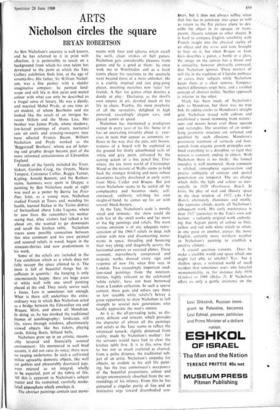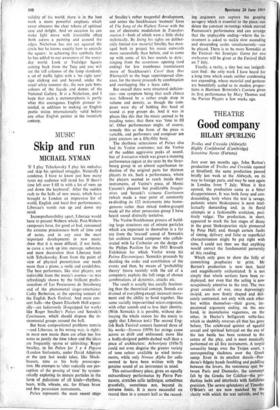Nicholson circles the square ARTS
BRYAN ROBERTSON
As Ben Nicholson's ancestry is well known, and he has referred to it in print with affection, it is permissible to touch on a background from which his own talent has developed to the point at which the Tate Gallery exhibition finds him, at the age of seventy-five. His father, Sir William Nichol- son, was a fine painter with a slender imaginative compass: he painted land- scape and still life in thin paint and muted colour with what can only be described as a frugal sense of luxury. He was a dandy, and married Mabel Pryde, at one time an art student, of whom Beerbohn said she
looked like the result of an intrigue be- tween Milton and the Mona Lisa. Her brother was James Pryde, whose shadowy, low-keyed paintings of streets, nocturnal cats on roofs and crossing-sweepers may have affected Francis Bacon. William Nicholson and Pryde worked as the 'Beggarstaff Brothers, whose use of letter- ing and graphic design became part of the more informed consciousness of Edwardian England.
Friends of the family included the Trees, Sickert, Gordon Craig, the Orpens, Marie Tempest, Constance Collier, Reggie Turner, Kipling, Arnold Bennett, and the Rothen- steins. Summers were spent in Dieppe; a painting by Ben Nicholson made at eight was used as a poster by Barrie for Peter Pan; later, as a young man, Nicholson studied French at Tours and, mending his health, learned Italian in the Ticino district of Switzerland above Lake Lugano, where he now lives. He remembers his mother saying that, after visitors had talked a lot about art, she wanted to go downstairs and scrub the kitchen table. Nicholson traces some possible connection between this nice comment and his own painted and scoured reliefs in wood, begun in the nineteen-thirties and now predominant in his work.
Some of the reliefs are included in the Tate exhibition which as a whole does not fully occupy the space allotted to it. The show is full of beautiful things but in- sufficient in quantity: the hanging is only intermittently happy; there are huge areas of white wall with one small painting placed at the end. They rarely suvive such a focus. Less is sometimes not enough. What is there still underlines the extra- ordinary way in which Ben Nicholson acted as a bridge between the Edwardian era and Braque, Mira, and above all Mondrian. In doing so, he has invoked the traditional themes of autobiography: landscape, still life, views through windows, affectionately viewed objects like bus tickets, playing cards, fishing floats, billiard balls.
Nicholson grew up in an artistic, reason- ably leisured and financially assured environment: life murmured in well bred accents, it did not raise its voice; there were no rasping undertones. In such a cultivated milieu agreeable domestic objects, like well cut goblets and pleasurably decorated jugs, were enjoyed as an integral, wholly to be expected, part of the fabric of life. All this is apparent in Nicholson's subject matter and the restrained, carefully modu- lated atmosphere which envelops it.
The abstract paintings contain taut move-
ments with lines and spheres which recall the swift, clean strokes of ball games.
Nicholson gets considerable pleasure from
games and he is good at them: he once took me to Wimbledon and as a keen tennis player his reactions to the spectacle
went beyond those of a mere onlooker. He is a craftily inspired and fast ping-pong player, inventing merciless new 'rules' for
friends. A flair for games often denotes a
dandy at play: Duchamp, as the devil's own umpire in art, devoted much of his life to chess; Picabia, the most prophetic of all the surrealists, delighted in high powered, exceedingly elegant cars, and played tennis at speed.
Nicholson has maintained a prodigious output in every year of his life. Some of it has an enervating triviality about it: exer- cises in taste that appear as automatic re- flexes in the way that the pale, soft brown, textures of a board will be exploited as the ground for thinly adumbrated veils of white and grey paint, enlivened by the scoring action of a fine pencil line. Else- where, the toy town world of Christopher Wood or the naïveté of Wallis seems to hold back the stronger thinking and more robust decorative faculty developed in early years from Miro, Calder and Braque. But just when Nicholson seems to be sealed off by complacency and becomes static, self- entranced, endlessly relishing his own sleight-of-hand, he conies up for air with several block-busters.
At the Tate, Nicholson's scale is mostly small and intimate: the show could do with less of the small works and far more of the big paintings and reliefs. The most serious omission is of any adequate repre- sentation of the 1966-7 reliefs in deep, rich colour with new and disconcerting move- ments in space, threading and bouncing their way along, and diagonally across, the horizontal convex or recessed planes. These resonant, marvellously compressed and majestic works showed every sign and response of new life when first seen in London. Two exceedingly important med- ium-sized paintings from the nineteen- thirties, highly relevant to the celebrated 'white reliefs', have not been borrowed from a London collection. In such a sparse context, these gaps and others (are there so few sizeable white reliefs?) betray a great opportunity to show Nicholson in full strength to several new generations who hardly appreciate the man's stature.
As it is, the all-pervading taste, so dis- crete, delicate and reticent, which provides the character of almost all the paintings and reliefs at the Tate seems to reflect the whimsical remark, slightly distanced from reality, made by Nicholson's mother: for the servants would have had to clear the kitchen table first. It is in this sense that he has not so much explored as charted, from a polite distance, the traditional sub- ject of an artist. Nicholson's empathy for objects, so evident in his still life paint- ing, has the true connoisseur's acceptance of the beautiful proportions, colour and design unconsciously absorbed from the sur- roundings of his infancy. From this he has extracted a singular purity of line and an instinctive urge toward disembodied con- tours, but it does not always suffice when that line has to penetrate into space as well
as return to the flat picture plane to des- cribe the object in its opaque, or trans- parent, illusory relation to other shapes. It is hard to compare English sensibility with French insight into the physical reality of an object and the verve and taste brought to bear on it; but when Braque or Juan Gris describes a guitar, a bottle or a glass. the image on the canvas has a thrust and a sensuality, however abstractly conveyed, that Nicholson ignores. These masters of still life in the tradition of Chardin embrace or caress their subjects while Nicholson keeps them at a clear remove. Tempera- mental differences reign here, and a rarefied concept of abstract reality. Neither approach is inferior to the other.
Much has been made of Nicholson's debt to Mondrian, but there was no true link. In adding circles to Mondrian's straight grid. Nicholson stayed with cubism and established a mood stemming from nature: suns and moons hover over those squares and rectangles. The severities of an under- lying geometric structure are softened and qualified by such allusions. Mondrian's passionate retention of verticals and hori- zontals from organic growth principles con- fined everything to a discipline so rigid that tension is constant, ending in climax. With Nicholson there is no finale: the formal interplay is well mannered, sharp comment is relished, atmospheric equivocation and precise ambiguity of contour and spatial penetration are temporal. The sea change which shifts the light and colour so mer- curially in 1928 (Porthnteor Beach, St lvc1s), the play of real and illusory space in the shop window of 1932, (Au ('hat Bone). alternately illuminate and muffle, like vaporous clouds, nearly all Nicholson's subsequent work. His early masterpiece is June 1937 (painting) in the Tate's own col- lection: a radiantly original work embody- ing that Aegean purity of colour in blue, yellow and red with white which so often, in one guise or another, pierces the more English, certainly more northern weather in Nicholson's painting to establish a positive climate.
A crucial question remains. Does he make a credible world and space which one might feel able to inhabit? Yes: but a shallow space, a restricted world of small incident that sometimes soars into forceful monumentality, in, for instance July /959 (Lindos) or 1968 (Delos 2). If Nicholson offers us only a gentle insistence on the
validity of his world, there is in the best work a more powerful emphasis which never obscures the clear tokens of spiritual ease and delight. And on occasion he can make light move with irresistible effect both across a painting and around the edges. Nicholson has not yet squared the circle but he knows exactly how to encircle the square: in achieving this symbolic feat he has added to our awareness of the every- day world. Look at Trafalgar Square coming back from the Tate and you will see the tall columns of the lamp standards, a set of traffic lights with a `no right turn' sign sticking out and beyond, under the usual white summer sky, the new pale bone colours of the facade and domes of the National Gallery. It is a Nicholson, and I hope that such a metamorphosis is partly what this courageous English pioneer in- tended, in addition to making an English poetic vision internationally valid before any other English painter in the twentieth century.



































 Previous page
Previous page